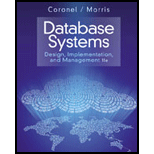
Database Systems: Design, Implementation, & Management
11th Edition
ISBN: 9781285196145
Author: Steven, Steven Morris, Carlos Coronel, Carlos, Coronel, Carlos; Morris, Carlos Coronel and Steven Morris, Carlos Coronel; Steven Morris, Steven Morris; Carlos Coronel
Publisher: Cengage Learning
expand_more
expand_more
format_list_bulleted
Concept explainers
Expert Solution & Answer
Chapter 8, Problem 22RQ
Explanation of Solution
Stored procedures:
Stored procedure is a collection of procedural and SQL code statements; it is directly called to operate against the data in the
- It has a unique name with the schema and stored in the database.
- A procedure may have input parameter, and output parameter.
- Stored procedures are stored in the database, and it will run whenever it is invoked.
Advantages of stored procedure:
- Stored procedures are designed and optimized to run more quickly.
- It is used to encapsulate and represent business transactions.
- Stored procedure reduces network traffic and also increases performance, because it is stored at the server and there won’t occur any transmission of individual SQL statements over the network...
Expert Solution & Answer
Want to see the full answer?
Check out a sample textbook solution
Students have asked these similar questions
I need help in explaining how I can demonstrate how the Laplace & Inverse transformations behaves in MATLAB transformation (ex: LIke in graph or something else)
You have made the Web solution with Node.js. please let me know what problems and benefits I would experience while making the Web solution here, as compared to any other Web solution you have developed in the past.
what problems and benefits/things to keep in mind as someone just learning
PHP is the server-side scripting language. MySQL is used with PHP to store all the data. EXPLAIN in details how to install and run the PHP/MySQL on your computer. List the issues and challenges I may encounter while making this set-up?
why I asked: I currently have issues logging into http://localhost/phpmyadmin/ and I tried using the command prompt in administrator to reset the password but I got the error LOCALHOST PORT not found.
Chapter 8 Solutions
Database Systems: Design, Implementation, & Management
Ch. 8 - What is a cross join? Give an example of its...Ch. 8 - What three join types are included in the outer...Ch. 8 - Using tables named T1 and T2, write a query...Ch. 8 - Prob. 4RQCh. 8 - Prob. 5RQCh. 8 - Prob. 6RQCh. 8 - Prob. 7RQCh. 8 - What does it mean to say that SQL operators are...Ch. 8 - Prob. 9RQCh. 8 - Prob. 10RQ
Ch. 8 - Prob. 11RQCh. 8 - Prob. 12RQCh. 8 - Prob. 13RQCh. 8 - Given the employee information in Question 11,...Ch. 8 - Prob. 15RQCh. 8 - Prob. 16RQCh. 8 - Prob. 17RQCh. 8 - Prob. 18RQCh. 8 - What string function should you use to list the...Ch. 8 - Prob. 20RQCh. 8 - Prob. 21RQCh. 8 - Prob. 22RQCh. 8 - Prob. 23RQCh. 8 - Prob. 24RQCh. 8 - Prob. 1PCh. 8 - Insert the data into the tables you created in...Ch. 8 - Prob. 3PCh. 8 - Prob. 4PCh. 8 - Prob. 5PCh. 8 - Prob. 6PCh. 8 - Prob. 7PCh. 8 - Prob. 8PCh. 8 - Prob. 9PCh. 8 - Modify the CUSTOMER table to include two new...Ch. 8 - Prob. 11PCh. 8 - Prob. 12PCh. 8 - Prob. 13PCh. 8 - Prob. 14PCh. 8 - Prob. 15PCh. 8 - Prob. 16PCh. 8 - Write a trigger to update the customer balance...Ch. 8 - Write a procedure to delete an invoice, giving the...Ch. 8 - Prob. 19PCh. 8 - Prob. 20PCh. 8 - Prob. 21PCh. 8 - Prob. 22PCh. 8 - Prob. 23PCh. 8 - Prob. 24PCh. 8 - Prob. 25PCh. 8 - Prob. 26PCh. 8 - Prob. 27PCh. 8 - Create a trigger named trg_line_total to write the...Ch. 8 - Create a trigger named trg_line_prod that...Ch. 8 - Create a stored procedure named prc_inv_amounts to...Ch. 8 - Create a procedure named prc_cus_balance_update...Ch. 8 - Modify the MODEL table to add the attribute and...Ch. 8 - Prob. 33PCh. 8 - Modify the CHARTER table to add the attributes...Ch. 8 - Write the sequence of commands required to update...Ch. 8 - Write the sequence of commands required to update...Ch. 8 - Write the command required to update the...Ch. 8 - Write the command required to update the...Ch. 8 - Write the command required to update the...Ch. 8 - Prob. 40PCh. 8 - Create a trigger named trg_char_hours that...Ch. 8 - Create a trigger named trg_pic_hours that...Ch. 8 - Create a trigger named trg_cust_balance that...Ch. 8 - Alter the DETAILRENTAL table to include a derived...Ch. 8 - Alter the VIDEO table to include an attribute...Ch. 8 - Update the VID_STATUS attribute of the VIDEO table...Ch. 8 - Alter the PRICE table to include an attribute...Ch. 8 - Prob. 48CCh. 8 - Prob. 51C
Knowledge Booster
Learn more about
Need a deep-dive on the concept behind this application? Look no further. Learn more about this topic, computer-science and related others by exploring similar questions and additional content below.Similar questions
- Capsim Team PowerPoint Presentations - Slide Title: Key LearningsWhat were the key learnings that you discovered as a team through your Capsim simulation?arrow_forwardWrite the SQL code that permits to implement the tables: Student and Transcript. NB: Add the constraints on the attributes – keys and other.arrow_forwardDraw an ERD that will involve the entity types: Professor, Student, Department and Course. Be sure to add relationship types, key attributes, attributes and multiplicity on the ERD.arrow_forward
arrow_back_ios
SEE MORE QUESTIONS
arrow_forward_ios
Recommended textbooks for you
 Principles of Information Systems (MindTap Course...Computer ScienceISBN:9781305971776Author:Ralph Stair, George ReynoldsPublisher:Cengage Learning
Principles of Information Systems (MindTap Course...Computer ScienceISBN:9781305971776Author:Ralph Stair, George ReynoldsPublisher:Cengage Learning Systems ArchitectureComputer ScienceISBN:9781305080195Author:Stephen D. BurdPublisher:Cengage Learning
Systems ArchitectureComputer ScienceISBN:9781305080195Author:Stephen D. BurdPublisher:Cengage Learning Database Systems: Design, Implementation, & Manag...Computer ScienceISBN:9781305627482Author:Carlos Coronel, Steven MorrisPublisher:Cengage Learning
Database Systems: Design, Implementation, & Manag...Computer ScienceISBN:9781305627482Author:Carlos Coronel, Steven MorrisPublisher:Cengage Learning Database Systems: Design, Implementation, & Manag...Computer ScienceISBN:9781285196145Author:Steven, Steven Morris, Carlos Coronel, Carlos, Coronel, Carlos; Morris, Carlos Coronel and Steven Morris, Carlos Coronel; Steven Morris, Steven Morris; Carlos CoronelPublisher:Cengage Learning
Database Systems: Design, Implementation, & Manag...Computer ScienceISBN:9781285196145Author:Steven, Steven Morris, Carlos Coronel, Carlos, Coronel, Carlos; Morris, Carlos Coronel and Steven Morris, Carlos Coronel; Steven Morris, Steven Morris; Carlos CoronelPublisher:Cengage Learning Management Of Information SecurityComputer ScienceISBN:9781337405713Author:WHITMAN, Michael.Publisher:Cengage Learning,
Management Of Information SecurityComputer ScienceISBN:9781337405713Author:WHITMAN, Michael.Publisher:Cengage Learning,

Principles of Information Systems (MindTap Course...
Computer Science
ISBN:9781305971776
Author:Ralph Stair, George Reynolds
Publisher:Cengage Learning


Systems Architecture
Computer Science
ISBN:9781305080195
Author:Stephen D. Burd
Publisher:Cengage Learning

Database Systems: Design, Implementation, & Manag...
Computer Science
ISBN:9781305627482
Author:Carlos Coronel, Steven Morris
Publisher:Cengage Learning

Database Systems: Design, Implementation, & Manag...
Computer Science
ISBN:9781285196145
Author:Steven, Steven Morris, Carlos Coronel, Carlos, Coronel, Carlos; Morris, Carlos Coronel and Steven Morris, Carlos Coronel; Steven Morris, Steven Morris; Carlos Coronel
Publisher:Cengage Learning

Management Of Information Security
Computer Science
ISBN:9781337405713
Author:WHITMAN, Michael.
Publisher:Cengage Learning,